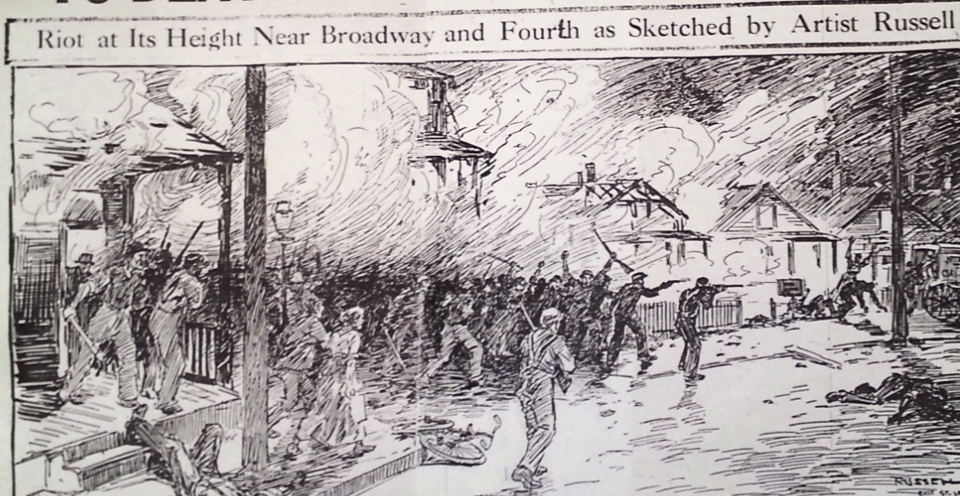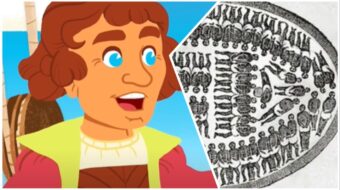
The East St. Louis riots (or massacres) of May and July 1917 were an outbreak of labor- and race-related violence that caused up to 200 deaths and extensive property damage. East St. Louis, Ill., is an industrial city on the east bank of the Mississippi River across from St. Louis, Mo. These incidents of 100 years ago have been described as the worst case of labor-related violence and among the worst race riots in 20th-century American history.
In 1917 the U.S. had an active economy boosted by World War I. With many workers now absent in the armed forces, industries were in need of labor. Seeking better work and living opportunities, as well as an escape from harsh conditions, the Great Migration of African Americans out of the South toward industrial centers across the North was well underway. Blacks were arriving in St. Louis during Spring 1917 at the rate of 2000 per week. Traditionally white unions sought to strengthen their bargaining position by hindering or excluding black workers, while industry owners utilized blacks as replacements or strikebreakers, adding to deep-seated societal divisions.
At the same time Louisiana farmers were worried about losing their labor force, and had requested East St. Louis Mayor Fred W. Mollman’s assistance to help discourage black migration.
Many blacks found work at the Aluminum Ore and the American Steel companies in East St. Louis. Some whites feared job and wage security from this new competition. That February, 470 African American workers were hired to replace white workers who had gone on strike against Aluminum Ore. Tensions between the groups escalated, including rumors of black men and white women fraternizing at a labor meeting on May 28, following which some 3000 white men marched into downtown East St. Louis and began attacking African Americans. The mobs stopped trolleys and streetcars, pulling black passengers out and beating them on the streets. With mobs destroying buildings and assaulting people, Ill. Gov. Frank O. Lowden called in the National Guard to prevent further rioting, and the mood eased somewhat for a few weeks.
The East St. Louis Central Labor Council responded to the rioting implying that “southern Negroes were misled by false advertisements and unscrupulous employment agents to come to East St. Louis in such numbers under false pretenses of secure jobs and decent living quarters.”
Little was done to prevent further problems. No precautions were taken to ensure white job security or to grant union recognition. No reforms were made in the police force which did little to quell the violence. This further increased the already-high level of hostilities towards African Americans.
On July 2, a car occupied by white males drove through a black area of the city and several shots were fired into a standing group. An hour later, a car containing four people, including a journalist and two police officers passed through the same area. Black residents, possibly assuming they were the original suspects, opened fire, killing one officer instantly and mortally wounding another.
Later that day, thousands of white spectators who assembled to view the detectives’ bloodstained automobile marched into the black section of town and started rioting. After cutting the water hoses of the fire department, the rioters burned entire sections of the city, shot inhabitants as they escaped the flames, and lynched several blacks. Guardsmen were called in, but according to contemporary accounts, they joined in the rioting rather than stop it. Young white women and girls brandishing clubs chased a black woman and called upon the men to kill her.
After the riots, the St. Louis Argus said, “The entire country has been aroused to a sense of shame and pity by the magnitude of the national disgrace enacted by the blood-thirsty rioters in East St. Louis Monday, July 2.”
According to the Post-Dispatch of St. Louis, “All the impartial witnesses agree that the police were either indifferent or encouraged the barbarities, and that the major part of the National Guard was indifferent or inactive. No organized effort was made to protect the Negroes or disperse the murdering groups…. Ten determined officers could have prevented most of the outrages. One hundred men acting with authority and vigor might have prevented any outrage.”
After the riots, varying estimates of the death toll circulated. The police chief estimated that 100 blacks had been killed. The renowned journalist Ida B. Wells reported in The Chicago Defender that 40-150 black people were killed. The NAACP estimated deaths at 100–200. Six thousand blacks were left homeless after their neighborhood was burned. The coroner specified nine white deaths, but the deaths of black victims were less clearly recorded: Activists argued that the true number of deaths would never be known because many corpses were neither recovered nor had passed through the hands of undertakers.
The ferocious brutality of the attacks and the failure of the authorities to protect innocent lives contributed to the radicalization of many blacks across the nation. Marcus Garvey, president of The Universal Negro Improvement Association (UNIA), declared, “This is no time for fine words, but a time to lift one’s voice against the savagery of a people who claim to be the dispensers of democracy.”
On July 6 the Chamber of Commerce met with the mayor to demand the resignation of top police officials and radical reform. In addition to the lives lost, mobs had caused extensive property damage. The Southern Railway Company’s warehouse was burned, with over 100 carloads of merchandise. A white theatre valued at more than $100,000, 44 freight cars and 312 houses were destroyed.
In response to the rioting, the NAACP sent W.E.B. DuBois and Martha Gruening to investigate the incident. They compiled a report entitled “Massacre at East St. Louis,” which was published in the NAACP’s magazine, The Crisis.
In New York City on July 28, 10,000 black people carrying signs marched down Fifth Avenue in a Silent Parade, protesting the riots. The march was organized by the NAACP and Du Bois, and other groups in Harlem. Women and children were dressed in white; the men were dressed in black.
Authorities were slow to respond to calls for an investigation. President Woodrow Wilson stated that his Department of Justice could not find enough evidence to justify federal action in the matter.
A Special Committee formed by the U.S. House of Representatives launched an investigation into police actions during the East St. Louis Riot. It found that the National Guard and the East St. Louis police force had not acted adequately during the riots, revealing that the police often fled from the scenes of murder and arson. Some even fled from station houses and refused to answer calls for help.
The investigation also resulted in the indictment of several members of the East St. Louis police force. Among those brought to trial was Dr. LeRoy Bundy, a dentist and prominent leader in the East St. Louis black community, who was formally charged with inciting a riot. The trial was held in the St. Clair county court. Bundy, along with 34 defendants, of whom ten were white, were given prison time in connection to the riot.
Adapted from Wikipedia and Tabitha C. Wang, University of Washington, Seattle. See more here.










